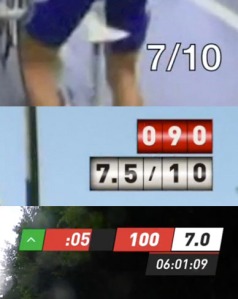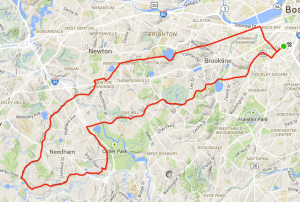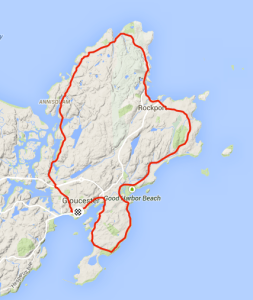With the frame decided on, I needed to make a few more key choices for parts to build up my new commuting bike. I knew that I was going to start out single speed and with a flat bar, but I wanted the option to switch to gears and a drop bar later on. I had also come across a couple things I definitely wanted to include, and they would further dictate my component choices.
While it may seem silly, the two things I knew I definitely wanted to have were a Sparse headlight and PDW full metal fenders.
The fenders were a more practical consideration. I’d used Velo Orange fenders on my Raleigh and while they were an asthetically good match, the installation wasn’t straightforward (partly because the frame wasn’t really built for fenders) and they always seem to have a bit of a rattle. I’d read a good review on the Blayleys blog and the appearance fit what I was going for. The city version are 45mm wide and PDW says they work with 28-38mm tires.
The Sparse light I first saw on the Firefly Adventure Team bikes, and wanted it just because it seemed cool. No other reason. I could say because it was theft-deterrent, but I just like the way it looks. Now the problem is that you can’t use the Sparse with center-pull or cantilever brakes, because it sits right where the cable should run. I already had the Cross Check, so I’d committed to cantis. V-brakes would be an option, but I wanted to keep
Extensive searching lead me to the mini-V brake. They are linear pull brakes just like regular Vs, but with shortened arms so they work with road levers. This chart at Gravelbike.com lists all the available models with arm lengths. The Paul Mini-motos definitely had bling going for them, but I ultimately decided on TRP CX8.4, again mostly because I felt like they were a good asthetic match. These would run the cable off to the side allowing for my Sparse light and would work with drop bar levers in the future. In the meantime, I got a set of SRAM 700 flat bar levers that were designed for road-style short pull brakes.
I wanted to start single speed, but eventually add a cassette, so after finding an old-but-unused SRAM Rival compact crankset on craigslist, I picked up a Wolf Tooth drop-stop chainring. This would work single speed, but would allow me to convert to 1×10 in the future if I wanted to. I made a similar decision about the wheelset, picking something with a freehub body so I could use a single cog now and switch to a cassette in the future.
In the end, this is what I ended up with:
- Frame: Surly Cross Check
- Wheelset: H+Son TB14 with 105 5700 hubs (10-speed cassette
- Brakes: TRP CX 8.4
- Crankset/BB: SRAM Rival with GXP bottom bracket (craigslist find)
- Chainring: Wolf Tooth 42t
- Cog: Surly 17t and Surly spacers
- Chain: Slightly used ultegra I had sitting around
- Brake levers: SRAM 700 flat bar levers
- Bar: Ritchey comp (craigslist)
- Stem: Ritchey comp (to match the bar)
- Seatpost: Richey WCS (again to match, they don’t make a comp in 0 offset, which I need for my relatively short legs)
- Saddle: Fizik Antares (craigslist)
- Fenders: PDW Full Metal, city version
- Headlight: Sparse
- Taillights: Fizik on the saddle + PDW Radbot for the seatpost and eventually on the rack
With all this together, I can put together a bike.

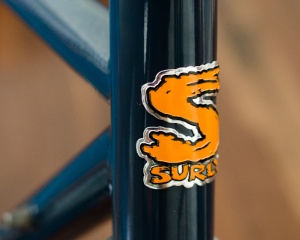 While I love my Raleigh, I wanted to get something a bit sturdier for year-round commuting. I wanted a frame that could take fenders and racks obviously, but I was also looking for something that could change as my needs do. For now, I have a short commute, only 2-3 miles each way depending on which location I’m working that day. But given how much driving in Boston infuriates me, I also wanted the ability to go a bit further.
While I love my Raleigh, I wanted to get something a bit sturdier for year-round commuting. I wanted a frame that could take fenders and racks obviously, but I was also looking for something that could change as my needs do. For now, I have a short commute, only 2-3 miles each way depending on which location I’m working that day. But given how much driving in Boston infuriates me, I also wanted the ability to go a bit further.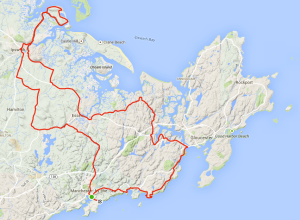
 The ride starts up along the North Shore, on a route I’ve done before that has plenty of great ocean views. Just before going onto Cape Ann, I turned west and headed up towards Ipswitch, then from there out Jeffrey’s Neck Road for some more water views, now of Plum Island Sound.
The ride starts up along the North Shore, on a route I’ve done before that has plenty of great ocean views. Just before going onto Cape Ann, I turned west and headed up towards Ipswitch, then from there out Jeffrey’s Neck Road for some more water views, now of Plum Island Sound.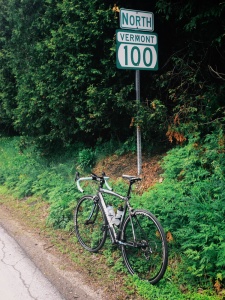 After the NE Randonneurs 100k, I was feeling confident about my ability to ride decent distances again. My wife and I had planned a trip to Waitsfield, VT for the end of May, and it seemed like a good chance to get a bit more cycling in.
After the NE Randonneurs 100k, I was feeling confident about my ability to ride decent distances again. My wife and I had planned a trip to Waitsfield, VT for the end of May, and it seemed like a good chance to get a bit more cycling in.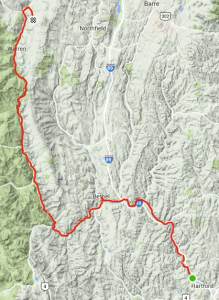
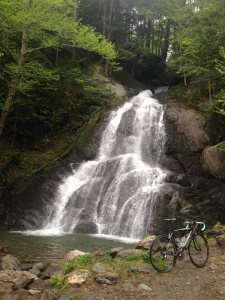


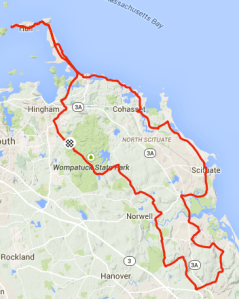
 The ride starts in Wompatuck State Park where there is plenty of free parking, and heads from there up to the windmill in Hull before doubling back. The ride was dead flat through Hull, and really all the way back along the coast down to Scituate. It was pretty though – lots of views of the Bay and amazing homes on the shoreline.
The ride starts in Wompatuck State Park where there is plenty of free parking, and heads from there up to the windmill in Hull before doubling back. The ride was dead flat through Hull, and really all the way back along the coast down to Scituate. It was pretty though – lots of views of the Bay and amazing homes on the shoreline.
